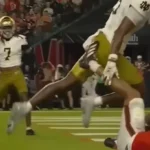In the high-stakes world of the NBA, where margins for error are thinner than a court’s sideline, the journey from prospect to player is a brutal gauntlet of skill, mentality, and opportunity. For Luke Travers, the Cleveland Cavaliers’ 2022 second-round draft pick, that journey has been a patient transcontinental shuffle between Australia’s National Basketball League (NBL) and the Cavaliers’ summer league roster. Now, as the 2025 offseason reaches its climax, Travers’s future in the league hinges on a single, make-or-break factor: the unwavering confidence to let his jump shot fly without a moment’s hesitation. As discussed on the insightful Wine and Gold Talk Podcast, Travers’s path to securing a roster spot is paved with more than just skill; it’s a mental battle of self-belief that will ultimately determine his NBA fate (source: Cleveland.com).
This isn’t just another training camp storyline. It’s a profound case study in the evolution of the modern basketball player and the immense psychological pressure faced by young athletes trying to carve out a role in the world’s best league. For Travers, a player lauded for everything except his shooting, developing a reliable three-point shot isn’t just about adding a tool to his kit; it’s about building the unshakable confidence to use it when the bright lights are on.
From Perth to Cleveland: The Making of a Versatile Prospect
To understand Luke Travers’s potential value, one must first look at his roots. Hailing from Perth, Australia, Travers was developed in the famed NBL Next Stars program, a pipeline that has produced talents like Josh Giddey and LaMelo Ball. As a 6’8” forward with guard skills, Travers’s game is built on a foundation of versatility. During his time with the Perth Wildcats, he showcased an all-around skillset that makes scouts drool: elite defensive instincts, exceptional passing vision for his size, and a relentless motor on the glass.
His stats in the NBL tell the story of a high-IQ glue guy. In the 2023-24 season, he averaged a well-rounded line of 9.5 points, 7.1 rebounds, and 4.2 assists per game while often guarding the opponent’s best player. He fills the box score in a way that doesn’t always scream superstar, but whispers of a player who positively impacts winning. He’s the type of player who makes the right cut, delivers the perfect pass in transition, and gets a crucial stop on defense. However, the glaring hole in his resume has always been his jump shot. He shot a concerning 25.8% from three-point range in that same NBL season, a number that immediately raises red flags for NBA executives looking for floor-spacers.
The Modern NBA’s Non-Negotiable: The Three-and-D Archetype
The NBA’s tactical evolution over the last decade has been nothing short of a revolution. The game has been completely reinvented around the three-point line and positional versatility. The coveted “three-and-D” wing, a player who can reliably knock down corner threes and switch defensively across multiple positions, has become the most valuable role player in the league. Teams are no longer interested in players who can’t space the floor; a non-shooter, no matter how gifted in other areas, allows defenses to collapse into the paint, stifling driving lanes for stars like Darius Garland and Donovan Mitchell.
This is the cold, hard reality of Travers’s situation. His passing, defense, and rebounding might earn him a look in training camp, but his shooting will be the deciding factor in whether he earns a contract. The Cavaliers’ roster construction, particularly with the presence of non-shooting big man Jarrett Allen, puts a premium on surrounding their core with as much shooting as possible. A player like Isaac Okoro, who faced similar criticisms early in his career, managed to carve out a crucial role by transforming his three-point shot into a respectable weapon, shooting 38.9% from deep in the 2023-24 season (source: NBA.com Advanced Stats). This is the blueprint Travers must follow.
Beyond Mechanics: The Psychology of Letting It Fly
The analysis on the Wine and Gold Talk Podcast cut to the heart of the matter: for Travers, the issue is as much psychological as it is mechanical. Countless players have beautiful shooting forms in an empty gym. The true test comes in a live game, with a defender closing out, and the pressure of a possession on the line. Will he catch and fire without a second thought? Or will he hesitate, pump fake, and drive into a crowded lane, effectively killing the offensive rhythm?
This is what coaches mean by “shooting confidence.” It’s the ingrained belief that your shot is going in, a belief that must be so deeply rooted that it overrides the fear of failure. For a young player fighting for his professional life, that fear can be paralyzing. Every missed shot feels like a step closer to being cut. Building confidence requires a short memory and a relentless work ethic. It requires taking thousands of reps until the motion becomes muscle memory, and then carrying that same conviction onto the court during a meaningless preseason game or a high-stakes practice scrimmage.
Historical Precedent: Stories of Transformation
The NBA is filled with stories of players who reinvented their shots to extend their careers. Perhaps the most famous modern example is Kawhi Leonard, who entered the league as a defensive specialist with a broken jumper and worked relentlessly to become a clutch shooter and MVP-caliber superstar.
Closer to home for Cavs fans is the story of Matthew Dellavedova. “Delly” was an undrafted guard whose sheer tenacity and will earned him a roster spot, but it was his improvement as a three-point shooter that allowed him to stay on the court for crucial minutes during the 2016 championship run. He transformed from a non-shooter to a reliable threat, which in turn opened up the rest of his game. More recently, Isaac Okoro’s dedication to his shot has made him a valuable two-way asset and earned him a significant payday. These are the models Luke Travers must study and emulate. It can be done, but it requires an almost obsessive level of dedication.
The Verdict: What Success Looks Like for Luke Travers
So, what does a successful 2025 training camp look like for Luke Travers? It won’t be defined by a highlight-reel dunk or a no-look pass. Success will be measured in a series of small, confident actions:
- Catching a kick-out pass from Donovan Mitchell and immediately rising up for a three-pointer without a hint of hesitation.
- Forcing a turnover on defense and confidently pulling up for a transition three if the defense sags off.
- Forcing the defense to respect him on the perimeter, which in turn opens up driving lanes for his exceptional playmaking.
He doesn’t need to become Stephen Curry. He simply needs to become a credible enough threat that defenders must close out on him, thus creating the space for his other elite skills to flourish. If he can showcase a reliable shot, perhaps in the 34-36% range from deep, he instantly transforms from a curious project into a viable rotational wing who fits the modern NBA archetype (source: Basketball-Reference.com Shooting Percentages).
The Cleveland Cavaliers have a decision to make. They’ve invested time in Travers’s development, and his intangible qualities are undeniable. But the NBA is a results-oriented business. Luke Travers possesses the work ethic, the basketball IQ, and the physical tools. Now, he must conquer the mental hurdle and prove he has the one skill the modern game demands above all else: shooting confidence. His NBA dream depends on it.





